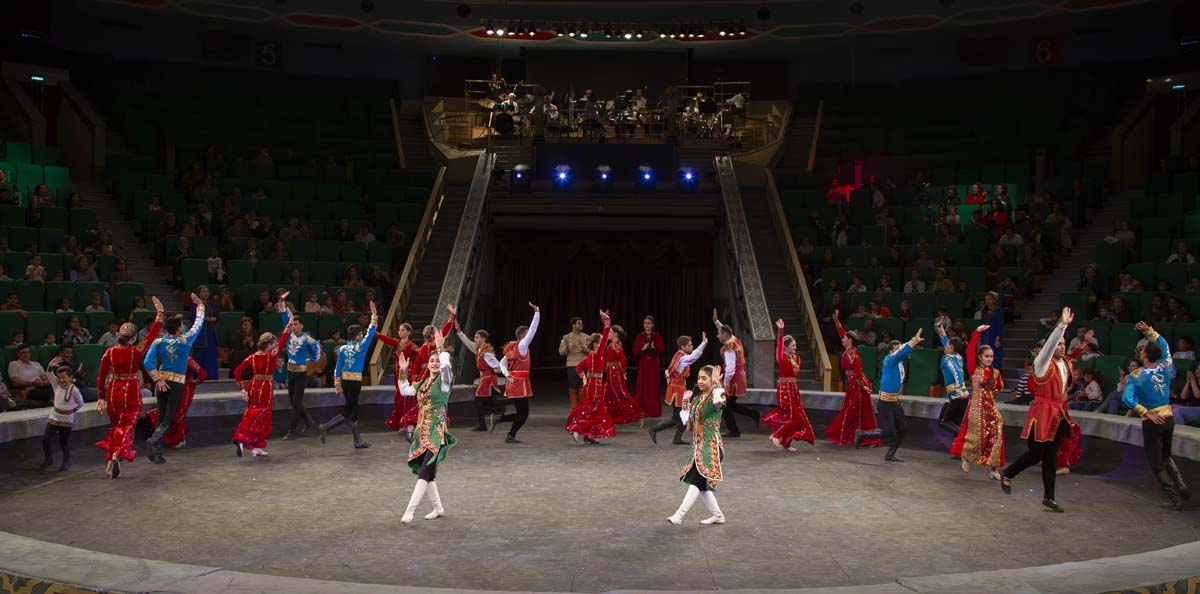The beauty and uniqueness of the Turkmen nature has always attracted travel enthusiasts, including painters, who aspire to capture the wonderful moments, passing through the prism of impressions and the view of life. A rich collection of landscapes, dedicated to the protected corners, historical and cultural monuments, surrounded by the odour of sanctity is kept in the Museum of Fine Arts of Turkmenistan. One of these works is a painting by Myati Orazberdyyev “Mausoleum of Mahtym”.
The artist used a 3D spacing solution, applying “bottom-upwards” foreshortening that allows to focus the audience's perception on the spiritual component of a historical and cultural monument. In a traveler’s eyes, the mausoleum appears in the frame of the sunrays against the background of a picturesque carpet with splashes of scarlet poppies. Emerald placers on the slopes of the mountains and gentle pink clouds in the light blue sky harmoniously complete the atmosphere of peace.
Architectural monuments depicted on paintings, have a valuable feature - they raise questions to spectators: who it is dedicated, when it was erected, where it is located. The interest in the history of their country and people is critical for the national identity, and the spiritual continuity forms a mental identity. Therefore, a painting represents not only artistic, but also a cultural and educational value.
Who is the person in memory of who the mausoleum was erected? The answer to this question one can find in the chronicles of the 15th century. The Turkmens lived in difficult times - the struggle with external enemies was exhausting. There was a need to unite the tribes. The spiritual leader, who was able to lead the representatives of isolated clans, was the famous Sufi - Mahtym-muazem, who lived in the Gurgen steppes (‘mahtym’ in Arabic means ‘master, ‘, ‘muazem’ – ‘great, glorified’).
According to the legend, “he has done justice for ten years, being the ruler in his province”, although the point here is not about the administrative leadership, but rather about the religious leadership. After his death in about 1494-1495, under Mahtym-muazem’s will, the Sufi pupils (murids) put his body onto a white female camel, so that it would choose the burial place. The white camel stopped near the ancient village of Magtym Gala in the picturesque valley of the Sumbar River.
In 1507-1508, a mausoleum was erected over the grave of the holy Sufi. It was built based on the best traditions of the national medieval architecture - with a double dome and a portal (peshtak). The interior walls of the building were decorated with ganch (clay) panels with the inscriptions in the Arabic language and narrative ornament.
Centuries left their destructive trail, changing the original view of many details of the mausoleum, but even now the monument looks majestic. Travelers from all over the country come here for the pilgrimage (ziyarat), begging their holy mufti for a successor, recovery, wellbeing, etc. Everyone finds peace of mind there. Mahtym-muazem significantly contributed to the history of the country, and the mausoleum, which is cherished by his grateful descendants, is a bright evidence of the greatness of Turkmen spirituality and the inseparable connection of generations.
The artist used a 3D spacing solution, applying “bottom-upwards” foreshortening that allows to focus the audience's perception on the spiritual component of a historical and cultural monument. In a traveler’s eyes, the mausoleum appears in the frame of the sunrays against the background of a picturesque carpet with splashes of scarlet poppies. Emerald placers on the slopes of the mountains and gentle pink clouds in the light blue sky harmoniously complete the atmosphere of peace.
Architectural monuments depicted on paintings, have a valuable feature - they raise questions to spectators: who it is dedicated, when it was erected, where it is located. The interest in the history of their country and people is critical for the national identity, and the spiritual continuity forms a mental identity. Therefore, a painting represents not only artistic, but also a cultural and educational value.
Who is the person in memory of who the mausoleum was erected? The answer to this question one can find in the chronicles of the 15th century. The Turkmens lived in difficult times - the struggle with external enemies was exhausting. There was a need to unite the tribes. The spiritual leader, who was able to lead the representatives of isolated clans, was the famous Sufi - Mahtym-muazem, who lived in the Gurgen steppes (‘mahtym’ in Arabic means ‘master, ‘, ‘muazem’ – ‘great, glorified’).
According to the legend, “he has done justice for ten years, being the ruler in his province”, although the point here is not about the administrative leadership, but rather about the religious leadership. After his death in about 1494-1495, under Mahtym-muazem’s will, the Sufi pupils (murids) put his body onto a white female camel, so that it would choose the burial place. The white camel stopped near the ancient village of Magtym Gala in the picturesque valley of the Sumbar River.
In 1507-1508, a mausoleum was erected over the grave of the holy Sufi. It was built based on the best traditions of the national medieval architecture - with a double dome and a portal (peshtak). The interior walls of the building were decorated with ganch (clay) panels with the inscriptions in the Arabic language and narrative ornament.
Centuries left their destructive trail, changing the original view of many details of the mausoleum, but even now the monument looks majestic. Travelers from all over the country come here for the pilgrimage (ziyarat), begging their holy mufti for a successor, recovery, wellbeing, etc. Everyone finds peace of mind there. Mahtym-muazem significantly contributed to the history of the country, and the mausoleum, which is cherished by his grateful descendants, is a bright evidence of the greatness of Turkmen spirituality and the inseparable connection of generations.






